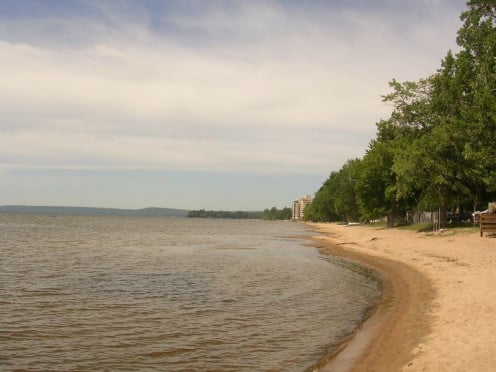Visiting Scenic Lake Nipissing at North Bay, Ontario: Gateway of the North



Defining waters at the Gateway of the North
[This visit occurred some years ago.]
Within Nipissing District in Northern Ontario is North Bay, often known as the Gateway of the North, given the road and rail (and previously canoe route) links which have passed through the locality (today, the former rail station is served by buses).
The District, created in 1858, the boundaries of which at its inception were larger than they are today, takes its name from Lake Nipissing. The Lake in turn takes its name from the Nipissing First Nation, thousands of whose members live in the wider area.
As a lakeside destination, North Bay particularly attracts visitors in summer. North Bay's Lakeshore Drive in particular has various hotels from which the Nipissing lakeshore is only a short walking distance. On a leafy promontory at the lakeshore, a feature with which I was especially struck, was Sunset Park (1), to which Sunset Boulevard leads from Lakeshore Drive.
The waters around the Manitou Islands (2) in Lake Nipissing, visible from North Bay some 10 kilometres distant, are accessible by salings on the vessel Chief Commanda II, with embarkation from its berth at 200 Memorial Drive, North Bay (3). Formerly the Islands were variously quarried for lime and mined for uranium. They are associated with legends regarding rivalries between First Nations peoples resulting in tragedy and hauntings. Today, the Manitou Islands are protected as a Provincial Park.
Interestingly — and tragically — it was off the Manitou Islands that the paddlewheel steamship 'John B. Fraser', launched in 1888, sank in 1893, with considerable loss of life (see the black and white photo, below). Its wreck was not located until 1972 after a long operation by local scuba divers.
North Bay is the seat of Nipissing University, which specializes in the liberal arts; as a linguist and former interpreter I note with interest that it offers a certificate in bilingualism.
The city itself is 14% Francophone; West Nipissing (35 kilometres from North Bay) is 65% Francophone.
Like Sudbury — another Northern Ontario city — North Bay struck me for its unhurried pace of life in a scenic setting, a sense of wide open spaces and proximity to nature.
May 2, 2020
Notes
(1) Tripadvisor has an inventory of photos of local scenes from Sunset Park; see also: https://www.tripadvisor.ca/Attraction_Review-g155000-d18980736-Reviews-Sunset_Park-North_Bay_Northeastern_Ontario_Ontario.html
(2) See also: https://www.northernontario.travel/northeastern-ontario/the-manitou-islands
(3) See also: https://chiefcommanda.com/cruises/manitou-islands/ The vessel's predecessor is now a restaurant.
Some sourcing: Wikipedia


Also worth seeing
In North Bay itself, attractions include: the Waterfront, sometimes regarded as the City's flagship attraction; Nipissing University's over 20 kilometres of trails; the Line Gallery 'dedicated to exhibiting and documenting contemporary Canadian drawing' (see also: https://culture.northbay.ca ); the imposing Pro-Cathedral of the Assumption, dating from 1905; the Discovery North Bay Museum; the Dionne Quints Museum; the Canadian Forces Museum of Aerospace Defence; and many others.
...
How to get there: Air Canada flies from Toronto Pearson Airport to North Bay / Jack Garland Airport, where car rental is available; road access to North Bay is via Highways 11 or 17; please check with the airline or your travel agent for up to date information.
MJFenn is an independent travel writer based in Ontario, Canada.

Other of my hubpages may also be of interest
- Visiting Thorne, 43% Francophone — Formerly Thorneville: Remembering Premier Hepburn's Visit to the
Formerly called Thorneville, the village of Thorne is located at an extremity of Ontario — linked since 1937 by Highway 63 — close to the boundary with Quebec at Témiscaming; interestingly, the village is 43% Francophone. - Visiting Latchford, Ontario: Remembering Sergeant Aubrey Cosens, Recipient of the Victoria Cross
At Latchford, Ontario is a bridge named for Sergeant Aubrey Cosens (1921-1945), who died in Germany while serving in The Queen's Own Rifles of Canada during World War Two and was posthumously awarded the Victoria Cross for his actions.








